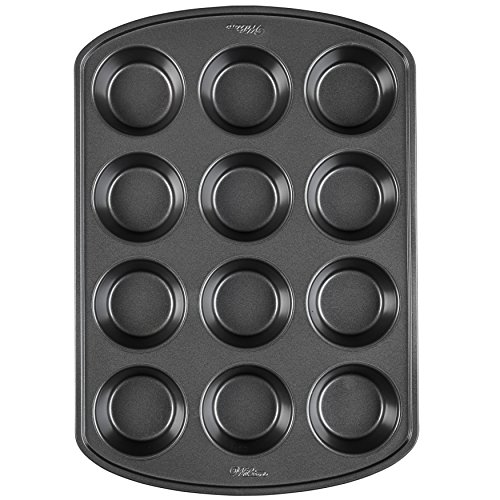Here’s a comprehensive guide covering all that you should know before purchasing a muffin pan.
Some Features of Muffin Pans to Keep In Mind
Construction
Muffin pans are made from a variety of materials and you need to weigh down certain factors before picking one. The muffin pan you pick should be constructed from a material that allows even heat distribution throughout. Even heat distribution prevents hot spots and guarantees even cooking. Moreover, you need to consider the material it’s been constructed from. It should always be non-stick and durable enough to resist corrosion and rust over time. The material shouldn’t warp and should be able to withstand high heat. You can also look for a dishwasher-compatible model to ease the cleaning process a little more.
Ease of use
Comfort and safety should always be considered when buying a baking item, as you cannot compromise on either of them. Look for features like extended handles or non-slip handles to make putting the pan inside or taking it out of the oven safer and easier. Also, prefer a design that allows increased airflow between the muffins as they bake. This generally results in perfectly risen and softer muffins. The design should also be easy to clean and maintain.
Capacity
Selecting the capacity of each cup and the whole tray depends on the user’s needs. Always check the dimensions of the pan you’re getting for the overall length and width and the dimensions of individual muffin holes as well. Some manufacturers offer the same cup capacity in their cup pan variants, so it’s important to check this. Make a rough estimate of how many people you’d be baking for during the month and what the serving sizes would be. For example, if you have young children at home, a muffin tray with small cup sizes would be ideal.
Best Material for Muffin Pans
Muffin and cupcake trays and pans are made from a variety of materials, but the three most common ones are aluminum, aluminized steel, and non-stick silicone. Unarguably, the material of a muffin pan is the most important deciding factor, as it determines the non-stick capability, durability, heat conductivity, and convenience of cleaning. Let’s explore the three common materials a little further:
Aluminum muffin pans
Aluminum is a favored element for baking cookware owing to its superior heat conductivity. It is also sufficiently rust-free and a lot more durable than other options on the market. The naturally smooth surface is easy to clean, maintain, and work with as well. Muffin pans made out of aluminum also have a nice shine on them that can perfectly complement other utensils in your kitchen.
Aluminized steel muffin pans
Heavy-gauge aluminized steel is perhaps the most preferable material for muffin pans. It’s favored due to the superior heat retention and conductivity it offers. This conductivity also ensures quick heat-ups and even cooking from the inside out. Other than that, aluminized steel is processed in a way that makes it more resistant to warping and rust, making it last longer.
Non-stick silicone muffin pans
Another durable muffin pan material is silicone. Silicone pans offer impressive heat resistance and versatility, as they can be used in freezers, for storage, and in microwaves. The material is super flexible as well and allows easy storage. You can simply fold a large tray and store it anywhere you like. It’ll unfold into its original shape when you need it. However, you’d always need a base tray to support it, as it can get wobbly with the batter in.
How to Clean and Maintain a Muffin Pan
Here are a few tips to clean a muffin tin:
- Make sure you’re following the washing instructions specific to the tray’s material. Determine what the pan is made from before washing it.
- For non-stick muffin tins, wash them immediately after use to keep the coating intact.
- Read carefully for instructions related to dishwashers. If it’s not dishwasher safe, wash it with a mild detergent, a soft sponge, and some hot water.
- Always avoid using harsh chemicals.
- When deep cleaning the muffin pan, use mild soap, baking soda, and water to clear out all the grease and residue instead of using strong, damaging chemicals. Do this by preheating your oven at 350-degrees Fahrenheit and pouring the mixture of baking soda and warm water into the muffin cups to cover them. Put it in the preheated oven for about 20 minutes, cool it down, and scrub away the residue left behind.
- Rinse the muffin pan thoroughly and properly dry it out before storing it.
- Store it in a place where it’s not stacked over or under other utensils. It will scratch the surface.
- Use wooden, silicone, or plastic utensils with the tray as steel spoons can scratch the non-stick layer.
- Don’t store food in the pan.
Muffin Pans vs. Cupcake Pans
Muffin pans come with straighter and deeper sides as compared to a cupcake pan. Cupcake pans have a standard size and cup shape. You are required to use paper to line the walls well in a cupcake pan, whereas, with a muffin pan, you don’t have to do any more than grease it. However, you can still use one pan for baking both muffins and cupcakes as well. The only difference between the two is the texture of the batter and how you put it in the cup. If you like your muffins with a crisp, rise top, get a muffin pan. This is because cupcakes turn out just fine in a muffin tray provided you pour in the right amount of batter. But, you cannot bake good, rise top muffins in a cupcake tray. Cupcake pans don’t come with ridges to support the rise-up.





